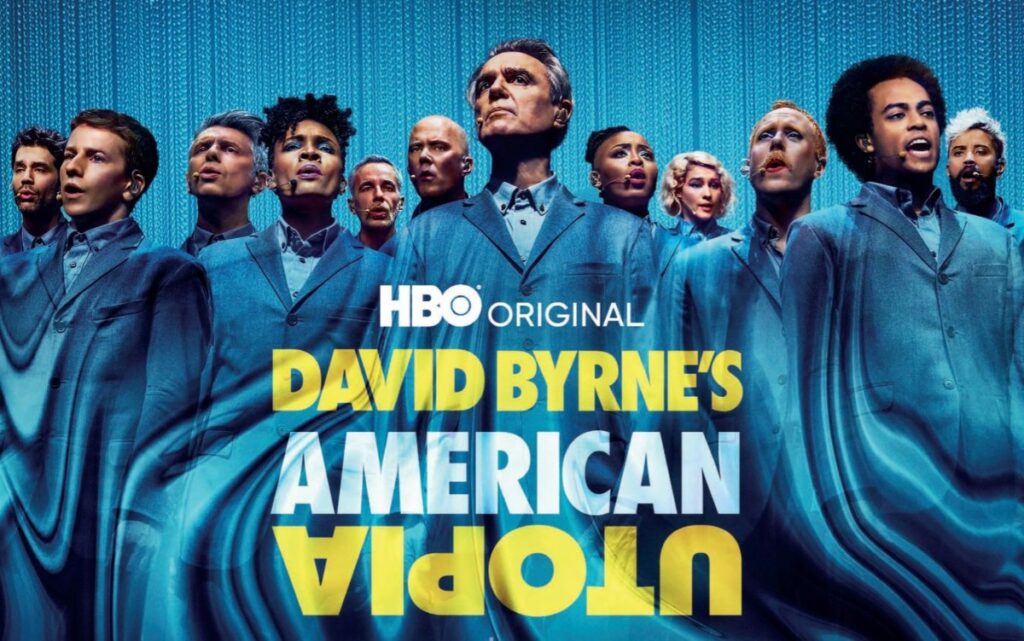The movie of American Utopia, based on the concert tour by new wave pioneer and ex-Talking Heads frontman David Byrne.
review by Jordan Lamash
Directed by: Spike Lee
Release Date: Oct. 17, 2020
Network: HBO
Length: 1h 45min
Back in 2018, new wave pioneer and ex-Talking Heads frontman, David Byrne, brought his American Utopia tour to the Northern Alberta Jubilee Auditorium to rave reviews. Unfortunately, it wasn’t until the following year that I became familiar with Byrne’s work and new wave as a whole. As Talking Heads quickly became one of my favourite bands of all time – with their eclectic mix of punk rock, pop, and funk – I was absolutely gutted when I found out that I missed my one chance to see their music performed live. Or so I thought.
Last month, HBO blessed subscribers with an exclusive taping of Byrne’s American Utopia Broadway show, a stage adaptation of the tour’s performance. Shot by veteran film director Spike Lee, the show takes place at the Hudson Theatre in New York, and was filmed in December of last year in the midst of a four-month residency.
Alongside Byrne, who provides lead vocals and guitar, is a team of eleven talented musicians, dancers, and vocalists from various parts of the world. Most notably, there are six percussionists out of the bunch. While this may seem a bit excessive, I wasn’t surprised to see this considering Byrne’s music has always drawn from drum-heavy genres like Latin and afrobeat.
Also worth mentioning is the show’s choreographer, Annie-B Parson, who has worked with Byrne on a handful of tours as far back as 2008. In addition, Parson has collaborated with numerous acclaimed musicians, ranging from David Bowie to Esperanza Spalding, while also being the artistic director of Brooklyn’s Big Dance Theater since 1991. With over 25 years of experience in professional choreography, it was going to be interesting to see how she would bridge the gap between the dancers and non-dancers in Byrne’s troupe.

When I put the show on, the first detail I noticed is that the musicians are completely untethered, playing entirely with wireless equipment. Byrne notes this to the audience midway through the set, explaining that it allows them to be more liberated and expressive while performing.
This is amplified even more by the set design, which simply consists of a beaded curtain outlining the stage, as well as the outfits, which sees each musician donned in a monochromatic grey suit. With no video screens to be found, the show forces you to pay close attention to the movements coming from each performer and what they represent.
As for the setlist, I wondered about the omission of notable Talking Heads classics such as “Psycho Killer,” “Life During Wartime,” and their popular cover of Al Green’s “Take Me to the River.” Upon further research, I discovered that the setlist of the Broadway performance was nearly identical to that of the tour’s, marking a stylistic choice to leave these songs out. I can’t blame Byrne for excluding them, as they don’t really fit the show’s overall narrative of human connection and collectivism. Also, I can see Byrne not wanting to dwell on the past too much by showcasing other important parts of his career, such as his solo work and collaborations, which are plentiful here.
Still, we get a number of Talking Heads hits to satisfy diehard fans, including “Burning Down the House,” “This Must Be the Place,” and “Once in a Lifetime.” One neat tidbit to mention is that “Once in a Lifetime” features choreography that’s indistinguishable from the 1984 concert film Stop Making Sense, demonstrating an artistic continuity that has lasted Byrne’s whole career. “Burning Down the House,” on the other hand, switches things up by transforming a naturally dance-y song into a rigid military march, akin to something you’d see at a parade.
Deep cuts like “I Zimbra,” “Slippery People,” and “Born Under Punches” play up the Latin sounds Talking Heads were known for by emphasizing the percussion and group vocal harmonies – even more in this performance than in their studio recordings. What’s most impressive is how syncopated the drums and percussion remain while being split up among six musicians. Simply put, they never miss a beat.
“Born Under Punches” incorporates the obligatory band introduction by having each musician add their part to the song as they’re introduced by Byrne. While I understood Byrne’s assertion to prove the authenticity of his show, and dispel any rumours of backing tracks, I felt that the introductions could have been better saved for a lighter song. With “Born Under Punches” being my absolute favourite Talking Heads song, I would have preferred that its dark, political message be left alone.
There are also a handful of references made to the current racial climate in America, which isn’t surprising seeing as Byrne has repeatedly collaborated with Latin and African artists. These references range from the lyrical message of “Bullet” (The bullet went into him / His stomach filled with food / Many fine meals he tasted there / But the bullet passed on through) to the choreography of “I Should Watch TV,” which sees the performers take a kneel half-way through the song as a portrait of Colin Kaepernick is projected onto the curtain.
Most powerfully, we get a cover of Janelle Monae’s “Hell You Talmbout,” which begs the audience to “say their name” each time a victim of police brutality is mentioned. To make sure these subjects were addressed as tastefully as possible, Byrne couldn’t have done a better job picking Lee, who has made race dynamics a focal point in his films.
The topics of home and community were another central theme to the show. Songs like “Everybody’s Coming to My House,” “Glass, Concrete & Stone” and “One Fine Day” really drove home the point that we, as humans, are all communal creatures. That we live boring, monotonous lives (exemplified in the performers’ grey suits) that are only made exciting by the relationships we form and the experiences we share. Applied more broadly, American Utopia’s themes of community, mixed with the topic of race relations, symbolize a growing need to accept multiculturalism in our society. To close out the set, Byrne and company perform the mid-80s Talking Heads hit “Road to Nowhere.” This time, they all leave the stage to march throughout the crowd, weaving in and out of the aisles in perfect formation as Byrne leads the way. “Road to Nowhere” provides the end of the show with a cautious optimism that’s made even more poignant by its opening lyrics (And we’re not little children / And we know what we want / And the future is certain / Give us time to work it out).
In terms of Lee’s direction, he does a beautiful job at shifting the perspective of the viewer with the camera work. At some moments, it feels like you’re a regular attendee, with the band being captured from afar like live performances typically are. However, at other times, you also feel like you’re part of the band, as the camera mingles with the musicians face-to-face. Visually, “Blind” was the most stunning performance, as a single key light was placed at the front of the stage to cast a shadow of the band members on the curtain behind them. It made every guitar strum, drum hit, and dance move seem larger than life. Parson’s choreography complemented the direction exceptionally by being synchronized, yet natural at the same time. Leaving these imperfections in the physical performance also enhanced the subject of humanness that Byrne is so enamored by lyrically.
All in all, American Utopia is a must for Talking Heads fans, and I’d highly recommend it to regular concertgoers who are looking to scratch that live performance itch. Fans of musical theatre will no doubt love the choreography and narrative, as it gives them something to decode. The setlist, while it could have been better, serves as a great starting point for newcomers. While mainly highlighting songs from American Utopia, it’s also a retrospective of Byrne’s entire career.
As we’re all chained to our couches given the current situation, American Utopia’s messages of community and connection provide a necessary escape from our new normal, while also reminding us to pick up the phone and call a friend every once in a while.
Streaming
Those who have a subscription to HBO will be able to watch the show on-demand through their television provider. For those who aren’t, there are still a few options available. A Crave TV subscription, including access to new HBO content, runs for $19.98/month.
Soundtrack album
Byrne has also seen fit to release a soundtrack album for American Utopia. Though not as impactful as actually watching the show, it allows you to at least experience the energetic musical performances. The soundtrack album can be found on most major streaming platforms including Apple Music, Spotify, and Tidal. If that’s not enough, you can check out the myriad of YouTube videos from the American Utopia album tour to get a sense of what the stage show was like.

